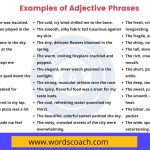What Is A Participle? Present & Past Participle
A participle is a verb form that functions in a sentence like an adjective or an adverb, but it retains some verb-like qualities.
There are two main types of participles:
Present Participle:
- Formed by adding “-ing” to the base verb (walk -> walking, sing -> singing).
- Acts like an adjective: describes a noun or pronoun.
- Can sometimes function as a verb phrase with additional words (Seeing the crowd, she stopped).
Examples:
- The smiling child waved at me. (describes the child)
- She enjoys dancing to Bollywood music. (describes the way she enjoys)
The present participle, formed by adding “-ing” to the base verb (walk -> walking, sing -> singing), is a verb form that can act like two different parts of speech in a sentence:
1. Adjective:
A present participle can modify a noun or pronoun, describing its state or action. It adds detail and creates a more vivid picture.
Examples:
- The laughing children played in the park. (describes the children’s state)
- She was reading a book by the window. (describes what she was doing)
- The sparkling water looked inviting. (describes the water)
2. Gerund (verb form acting as a noun):
In some cases, the present participle can function as a noun itself, called a gerund. Here, the “-ing” form acts more like a base verb and can be used in various noun roles.
Examples:
- Dancing is her passion. (gerund as subject)
- I enjoy reading in the evenings. (gerund as object of the verb)
- He considered leaving the job. (gerund as object of the preposition)
Past Participle:
- Usually formed by adding “-ed” to the base verb (walk -> walked, sing -> sung). Some verbs have irregular past participles (be -> been, take -> taken).
- Acts like an adjective: describes a noun or pronoun.
- Used with helping verbs (have, be) to form perfect tenses (I have eaten, The cake was decorated).
- Can be used in passive voice constructions (The cookies were baked by me).
Examples:
- The tired dancers needed a break. (describes the dancers)
- We have finished painting the house. (perfect tense)
- The prize was awarded to the winner. (passive voice)
The past participle, a verb form that often ends in “-ed” (walked, sung) or follows irregular patterns (written, taken), functions in various ways within a sentence.
Here’s a breakdown of its usages and examples:
1. Adjective:
Just like the present participle, the past participle can modify a noun or pronoun, describing the state resulting from a past action.
Examples:
- The tired runner crossed the finish line. (describes the runner’s state)
- The broken window needed to be repaired. (describes the window’s condition)
- The painted walls brightened the room. (describes the state of the walls)
2. Forming Perfect Tenses:
The past participle is crucial for constructing perfect tenses (present perfect, past perfect, future perfect). These tenses express actions completed at a specific point in the past or before another action.
Examples:
- I have eaten breakfast already. (present perfect)
- We had finished dinner by the time they arrived. (past perfect)
- She will have graduated by next summer. (future perfect)
3. Passive Voice Constructions:
The past participle is used with the verb “to be” to create passive voice sentences where the focus is on the object of the action.
Examples:
- The cake was baked by my grandmother. (passive voice)
- The book was written by a famous author. (passive voice)
4. Modals in the Past:
Past participles can also be used with modal verbs like “could have,” “should have,” and “might have” to talk about possibilities or obligations in the past that weren’t fulfilled.
Example:
She could have studied harder for the exam. (modal verb with past participle)
Participles, both present and past, add significant power and flexibility to your writing. They can act as adjectives, forming the foundation of descriptive and engaging sentences. They can also function as verb forms, creating perfect tenses and passive voice constructions.





